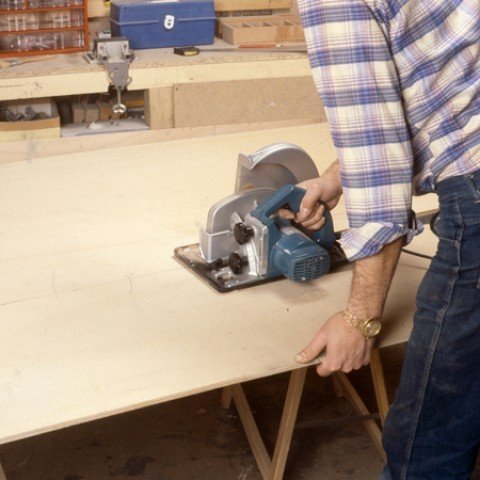A door is a wooden, metal or glass object used to close a given room or space. This device is ubiquitous in our lives, so it seems important to know how to make it especially for those who wish to build their own home.
You want to make a door? And you do not know how? We offer you this article, an easy guide that will allow you to make a beautiful Plywood door that is strong and easy to build.
Making a Plywood Door
Rather than using solid wood, which is more expensive and heavier, we used two plywood plates to make this flat door. In addition, we left it up to everyone to decide on the dimensions according to their own needs.
Necessary material
- Set square
- Circular Handsaw
- Tape Measure
- Folding Meter
- Wood Wedges
- Clamps
- Screwdrivers
- Hammer
- Drill with Depth Measurement
- Wood drill
- Chisels
- Colored Pencils
- Brushes
- Nail Pusher
Steps
- Structure
- Hinges and lock
- Finishing the door
STRUCTURE
- The door is made of two plywood plates joined together by a battens wooden frame. The interior space thus created is filled with glass wool. Also, four mitered cleats will be placed at each side of the panel for reinforcement on each side, to ensure maximum rigidity.

- For panels of this size, use a circular saw. Both panels must be perfectly identical measurements. Therefore, the tracing must be accurate and you could either cut both plates on top of each other or cut each panel at a time.
Proceed smoothly, holding the side of the panel with one hand, otherwise, the panel can break or you can lose the right path of the tracing.

- When buying the cleats, check the straightness of the cleats and ensure they’re not deformed. Take this into account to avoid any unpleasant surprises. Use cleats of 40 X 40 mm section. Glue the cleats with vinyl glue.

- Arrange the cleats to form a frame on the plywood panel. Hold both elements together with clamps.

- Determine the support point location of the reinforcements cleats. To reinforce the frame, you have to mark at 45 ° on both vertical sides of the frame. This mark must be precise so the reinforcement cleats can fit perfectly to the frame.

- After tracing, measure the distance between the two marks to find the length of the reinforcement cleats (5 wooden cleats needed).

- Nail the four reinforcement cleats into each corner of the frame. They must be perfectly joined.

- Nail the fifth cleat to the frame at the location of the lock.

- Before you lay the second plywood sheet, fill the void created by the frame with glass wool. The entire interior of the door is upholstered, not to mention the corners formed by the reinforcement cleats. This glass wool is cut with a simple pair of scissors.

- Gently lay the second plate on the glued frame. Be careful, the glass wool should not exceed the frame cleats. Hold the door firmly using clamps.

INSTALLING HINGES AND LOCK
- The hinges consist of two elements: the male part, or hinge, which is embedded in the wall and the female part which is fixed in the edge of the door (here; the cleat). We have sorted here only the female part, the laying of the hinges involving other notions (masonry in particular). The male parts and the female parts must match so that the pivoting of the door can be done.

- Here, we’re going to recess the two brass hinges. Without them, it would be an obstacle to the proper closing or opening of the door. Locate their location on the edge side and hollow out with a chisel to a thickness corresponding to that of the support of the brass hinges.

- When you have fitted the brass hinges to the door edge, screw them tight and they should be vertically aligned.

- Now comes the tracing of the lock. Remember when you install the fifth cleat, that’s where your lock will go. You’ll have to mark the rectangle entry section of the lock, along with the edge opposite to where the hinges are attached.
The fifth cleat was intended to increase the thickness of the frame where the lock can be installed and your support lock cleat must be longer in terms of length compared to your lock, especially if you have a mortise lock, so keep that in mind.

- In order to fit the lock, you must pierce the edge of the door. Start by determining the depth required and adjust the depth guide of the drill.

- Drill several holes side by side by adjusting the depth of cut beforehand. The diameter of the wood drill corresponds to the width of the space to be excavated. Basically, digging the lock hole just enough so the lock can fit in perfectly.

- When you have pierced the entire width of the lock, fix the remaining wood with a chisel.

- Determine the location of the front plate of the lock, called the faceplate. There are several types of locks, but as we’re constructing an interior door, a simple lock, extra-flat is enough. Given the structure of our door, an extra flat door lock or mortise is preferable.

- Then dig with a wide chisel so that the faceplate is flush fitting with the edge. The depth of the notch should match the thickness of the faceplate as well.

- Identify the holes to be drilled for the passage of the key (called “entry barrel”) and for the lever handle lock. Drill well perpendicular to the lock.

- Finally, you can finally put the lock in place using the fixing screws after a blank mounting and any corrections you may need to make.

FINISHING THE DOOR
- Now that the door is finished, you can proceed to the painting. You can paint it or tint it. It is useless to varnish, the wood is not remarkable and it’s best to dye it. Choose the shade that will best match your interior. First, try shades on plywood scraps.

- The choice of accessories is very large and you can put rosettes that will give a little style to your door.

- Make sure all nails are well put and the lock is firmly placed.

- The last step is to put the lock handle in place.

That’s it,
Tell us which DIY you want to see next on our platform?
